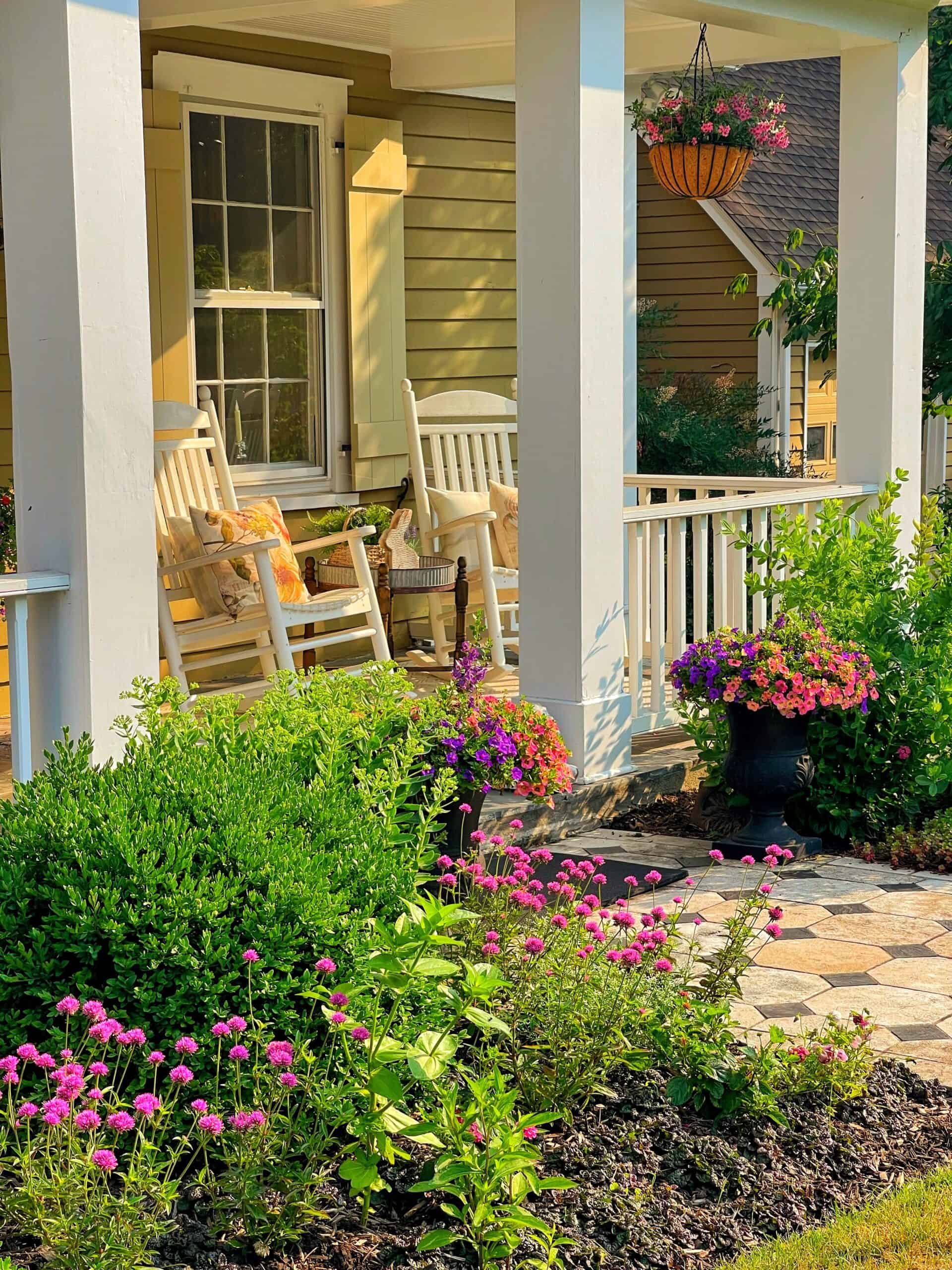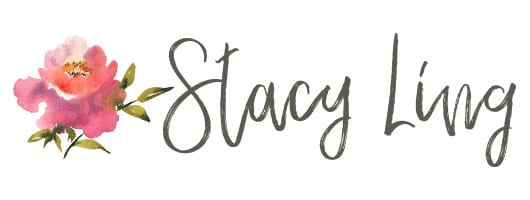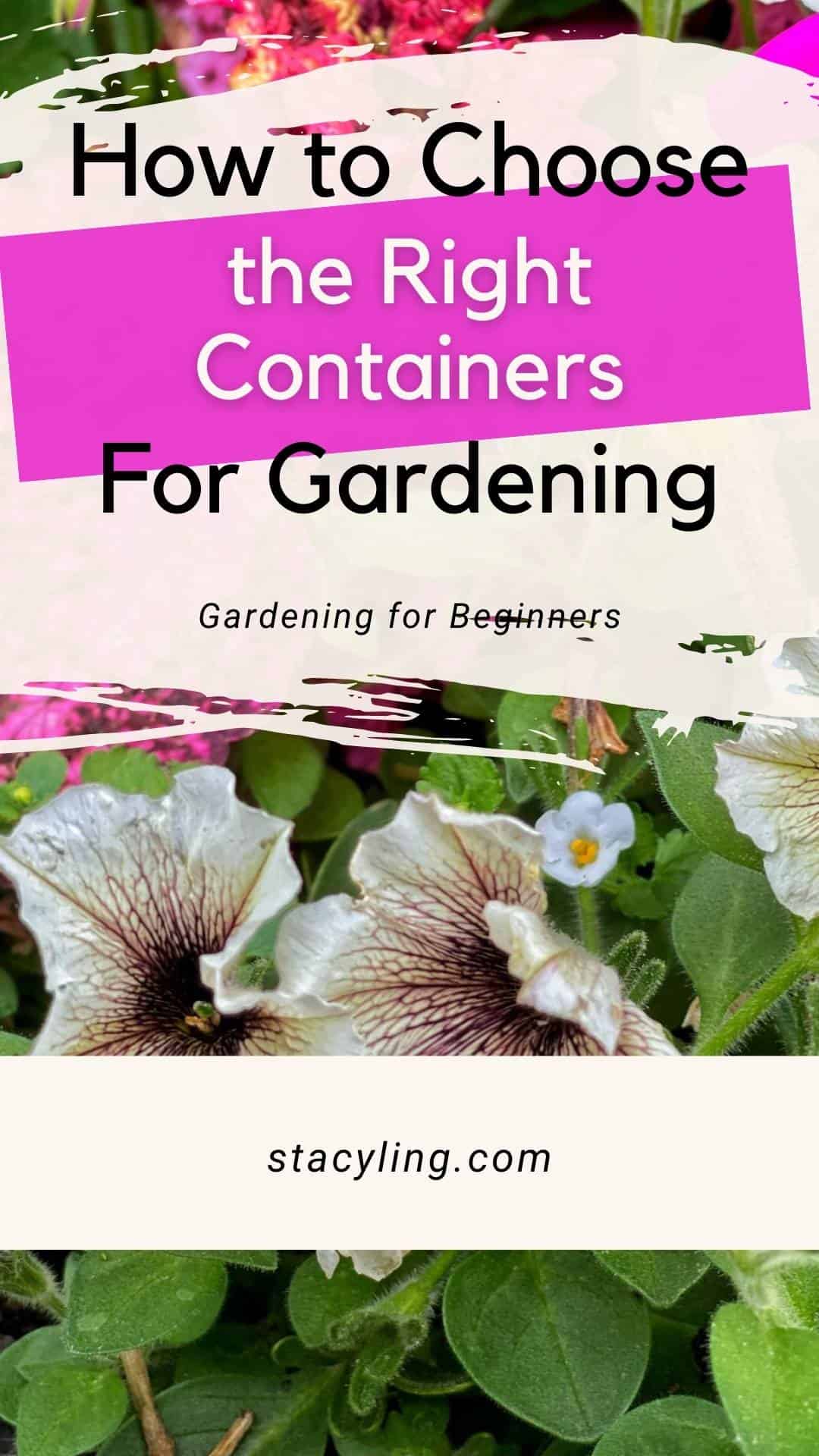Say goodbye to boring pots and hello to gorgeous containers filled with potted flowers. Learn about drainage, material options, and styling tips to bring out the beauty of your plants and add a touch of personality to your home or garden.
Your vibrant potted flowers deserve a home that complements their beauty! Choosing the perfect planter goes beyond just aesthetics. Because the right container can impact your plant’s health, growth, and overall happiness.
So today, I’m spilling the secrets to selecting the ideal planter for your potted flowers, ensuring they thrive and blossom into stunning additions to your indoor or outdoor space.
(Posts on stacyling.com may contain affiliate links. Click HERE for full disclosure.)
Why Choosing the Right Outdoor Planter Matters
Whether you grow flowers, herbs, or vegetables, limited space shouldn’t hold you back from enjoying the beauty of gardening! Container gardens offer a fantastic solution for anyone, regardless of the size, shape, or location of their outdoor area. With containers, you can turn any sunny balcony, patio, or even a windowsill into a thriving miniature garden.
But choosing the right container is key. Planters come in a wide variety of materials, purposes, and sizes. Each has its advantages and disadvantages. Some prioritize durability and weather resistance, while others might affect how quickly the soil dries out.
Don’t forget about aesthetics either! From classic to modern, there’s a planter style to match any taste, whether you prefer a rustic farmhouse look or a touch of French country charm. So before you dive into planting, consider the different options available to find the perfect container to match your needs and style.
With so many beautiful planters on the market, you can add a touch of personality to your garden while creating a flourishing home for your plants! (And I’m sharing a few favorites at the end of this post)

How to Choose Containers for Your Potted Flowers
Before choosing a container for potted flowers, consider what style you gravitate to. Do you love natural or organic colors and textures? Do you prefer a sleek modern look or something more vintage?
There are several different types of planters to consider. And they each have their pros and cons. Consider your price point too before shopping around because some containers can be pretty pricey!
When I am shopping around for planters, I think about where I plan to use them, my budget, and the aesthetic I’m striving for.
Here are some different types of flower pots to look for that will pair with your aesthetic.

Growing Potted Flowers in Plastic Containers
In general, plastic or resin-type containers are pretty weather-resistant and quite durable. Some are made so well that they almost look like true terracotta, stone, or concrete. They help plants retain moisture and are much lighter to move around than other types of containers.
As such, they tend to be less expensive. However, that depends on the overall appearance of the containers. Since these types of containers help plants retain moisture, it’s easier to overwater plants – which isn’t a good thing. (To learn more about watering your garden plants, read this post.)
I have several resin containers in my gardens that look just like terracotta that I’ve had for several years. And I love them!
You can find some truly beautiful plastic or resin containers for gardening that look like their organic counterparts. However, some plastic containers or resin pots look cheap and not well made. If the aesthetic does not matter, then get what you want.
But if you want the plastic or resin pots to look more authentic, then you’ve got to look at the details and ask yourself, does this look like the real thing? If it doesn’t, put it back on the shelf. So keep that in mind when shopping shopping for plastic or resin pots.


Growing Flowers in a Wood Planter
Wooden containers are another option for growing plants. These planters come in various sizes and shapes and are generally made from pine, teak, or cedar.
When planting in wood-based containers, I recommend adding some sort of lining because over time, that wood will break down and rot. If you don’t care about future wood rot, then lining wood pots may not be an issue for you.
Cedar or teak lasts longer than some other types of woods, but add a liner regardless to extend the useful life.

Potting Flowers in Metal Containers
I love the look of metal containers, don’t you? They add some texture and color to the garden or decor that helps make some plants and flowers pop. Metal containers last a long time and weather well when exposed to the elements. Be sure to make sure there are good drainage holes as not all metal containers have them.
If drainage holes are needed, simply grab a drill and make a few holes so water can drain out and not water log plants.
I love to thrift for metal buckets, urns, boiling pots, teapots, watering cans, and other types of items that would work well as a planter. One of my favorite finds is an old copper boiling pot that I use on my front porch for tropical hibiscus flowers.
So don’t feel limited by what you see in stores or online because secondhand stores are a gold mine for unique ideas that work well on a budget.

Using Terracotta or Clay Pot Containers for Flowers and Indoor Plants
Terra cotta or clay pots are another type of container that gardeners use. These pots are made from clay and are usually fired at high temperatures, making them durable and heat resistant.
Clay pots come in various sizes and shapes and are readily available. The drawback to using terracotta or clay pot containers is that they draw moisture away from plants, which dries planters out more quickly.
So you might need to water more often if using terracotta or clay pots as opposed to resin. Such containers are perfect for succulent-type plants that prefer drier soil conditions.
While these types of planters are more durable in one regard, they break more easily and are not made to withstand extreme winter conditions. So be sure to handle them with care and bring them indoors or protect them when frosts arrive. Moreover, clay pots can be pretty heavy if they are larger and filled with soil.
And while that sounds like a lot of negatives, terracotta clay pots add lots of color and texture to the garden and are beyond beautiful! I’m a huge fan of using them but make sure I keep the above in mind when deciding where to use them in my gardens and outdoor living spaces.

Stone or Concrete Containers
Concrete pots are also used by gardeners. They are easy to make and can last for several years. However, concrete pots need to be sealed with a sealant every few months to keep water out.
If you live in an area where freezing temperatures occur, then you will need to add insulation to prevent the pot from cracking during cold weather or move them indoors (if you can!)
I’ve not used concrete planters until recently. We found some GORGEOUS concrete planters tucked away in the garden shed and behind the fence shortly after moving here and I love them. But they are extremely heavy so be mindful where you place them because they will not be easy to move around later.

Window Boxes for Potted Flowers
Perfect for adding a touch of charm and color to your home’s exterior, window boxes attach directly to window sills and create a beautiful stage for a variety of plants.
Window boxes come in a wide range of materials, including weather-resistant plastic for a low-maintenance option, classic wood for a natural look, lightweight fiberglass for easy maneuverability, and durable metal for a touch of elegance. So choose the look that complements the aesthetic of your home or garden shed.
Window boxes are ideal for showcasing cascading flowers like petunias, trailing verbena, and delicate lobelia. Their proximity to your windows allows you to enjoy their beauty and fragrance up close.
Just be sure to choose plants that thrive in similar sunlight conditions as the window they’ll be displayed in. For south-facing windows, opt for sun-loving varieties, while north-facing windows will suit plants that prefer partial shade.
Because window boxes tend to dry out a little quicker, I recommend using a drip irrigation system set on a timer so watering is super easy during the hottest days of summer.

Growing Flowers in Hanging Baskets
Hanging baskets bring a touch of cascading beauty to any patio or porch. They’re a great way to add vertical interest and maximize growing space, especially on balconies or in smaller gardens. Hanging baskets offer several advantages for your plants:
- Excellent Drainage: Many hanging baskets are designed with drainage holes on the sides or using coco mats, allowing excess water to escape and preventing root rot, a common problem in container gardens.
- Enhanced Airflow: The elevated position of hanging baskets promotes good air circulation around the plants, which helps them stay healthy and disease-free.
- Abundant Sunlight: Depending on their placement, hanging baskets can receive more direct sunlight compared to planters on the ground, ideal for sun-loving flowers and cascading vines.
However, there are other factors to consider too like wind exposure and how quickly they dry out. Because hanging baskets swing in the breeze, strong winds may damage delicate plants or knock over the entire basket. If you live in a windy area, choose hardier plants that can tolerate some movement, or opt for a sheltered location for your hanging display.
And much like growing potted flowers in window boxes, I’d run a drip irrigation line to your hanging baskets too.

Potting Your Flower Garden in Self-Watering Containers Like Aquapots
Self-watering planters are a huge help if you want to cut down on manual watering or if you plant a garden that is not close to a water source. And right now, I’m a huge fan of the Aquapots that are sold by Proven Winners.
Invented by award-winning landscape architect Jack Barnwell, AquaPots are a game-changer for busy plant parents or those who struggle to maintain consistent watering. These innovative planters incorporate a self-watering system designed to take the guesswork out of keeping your potted plants hydrated.
AquaPots feature a built-in water reservoir at the bottom of the container. A water level indicator allows you to easily monitor the water level and refill the reservoir as needed. Here’s what makes them special for potted flowers:
- Self-Watering Design: A separation layer prevents the potting mix from directly contacting the water reservoir, ensuring proper aeration for healthy root growth. This allows the plant to access water at its own pace through a special wicking system, eliminating the risk of overwatering or underwatering.
- Reduced Maintenance: AquaPots significantly reduce the frequency of watering required, making them ideal for forgetful plant owners or those with busy schedules. They’re also perfect for plants with specific watering needs, as they help maintain consistent moisture levels.
- Stylish Design: AquaPots come in a variety of sizes and styles to complement any décor, indoors or outdoors. They’re crafted from high-quality materials for long-lasting durability and beauty.
With AquaPots, you can enjoy thriving plants with minimal effort, allowing you to focus on the beauty and joy they bring to your space. And they best part? They are readily available through Proven Winners.
Flipping a Thrift Store Find into an Outdoor Planter for Potted Flowers
Hitting the jackpot at a thrift store isn’t just about scoring a great deal on clothes or furniture. You can also unearth unique and interesting planters with a little imagination! Here’s how to transform a thrift store find into a charming home for your plants.
Keep an eye out for interesting containers with good drainage or the potential for adding drainage holes. Tin buckets, ceramic bowls, tea kettles, colanders, and even sepatu (Indonesian woven baskets) can all be repurposed into creative planters. Look for items in various sizes to accommodate different plants and consider the overall aesthetic you want to achieve in your space.
Once you’ve chosen your potential planter, give it a thorough cleaning to remove any dirt or dust. You can also paint it a fresh color or add decorative touches to personalize it and match your existing décor. With a little creativity, you can transform a pre-loved item into a one-of-a-kind planter that injects vintage charm into your home or garden.

Choosing the Right Plants for Your Containers
Choosing the perfect pot for your plant isn’t a one-size-fits-all situation! Just like your favorite outfit, a planter should match your plant’s style and needs. So before you pot up your flowers think through through the following:
- Drainage, Drainage, Drainage! Excess water can spell disaster for some plants. Pick a container with drainage holes, or if you fall in love with a pot without them, be sure to add them yourself.
- Size Matters: Think about how big your plant will grow! A pot that’s too small will leave your plant feeling cramped, while one that’s too big can lead to moisture problems. Aim for a pot 1-2 inches larger than the root ball.
- Location Location Location: Make sure you choose the right plants that are suited for the light conditions where you’ll be maintaining your potted flowers. Proper light matters for lots of healthy blooms.
- Material Marvels: Plastic offers lightweight portability, while terracotta breathes for happy roots. Consider the climate and your plant’s needs when choosing a material.
By keeping these tips in mind, you can select the perfect pot to set your plant up for success.

10 Essential Tips for Growing Potted Flowers in Planters
Container gardening is your gateway to a vibrant world of blooms for your balcony, patio, porch, outdoor living space, and windowsill. It’s a flexible way to bring life and color to any space, but a few key tricks will ensure your miniature gardens thrive.
- Add a slow-release fertilizer to your potting mix when planting. Give them a weekly bloom booster with a water-soluble solution. But understand each plant’s specific needs to find the perfect fertilizer for those particular plants!
- Different plants need containers that match their root system’s size. Not too small, not too big, but just the right size for comfortable growth and the number of plants you are using.
- Consider your local climate and the amount of sunshine your space gets when choosing your plant companions.
- Create fun plant combinations using the “thriller, filler, spiller” technique! A tall, eye-catching plant (the thriller) is the star of the show. Next, add medium-height, billowy plants (the fillers) to make it lush and full. Finally, add cascading plants (the spillers) to soften the hard lines of your containers by tumbling over the pot’s edge.
- Don’t have a lot of floor space but need more flowers in your life? Think vertically and grow up a trellis or stack pots to create a vertical explosion of colorful blooms.
- Invest in an automatic drip irrigation system. This handy tool delivers water directly to the roots, promoting healthy growth and saving you precious time (and maybe a few forgotten watering days!).
- Make sure whatever container you use has drainage holes. They allow excess water to escape which prevents plants from getting waterlogged. If drainage holes are missing, drill them yourself.
- Deadheading flowers encourage new blooms and keeps your plant looking its absolute best!
- Group plants with similar watering and light requirements so they thrive and makes caring for them a breeze.
- When you travel, make it easier for caretakers to care for your outdoor planters by pulling them together in one area near a water source (if possible). Consider pulling them into the shade while you are gone so they don’t dry out as quickly in the summer heat.
With these tips in your arsenal, you’re ready to create a thriving container garden that’s bursting with life and personality!

More About Choosing Outdoor Planters for Potted Flowers
What is your favorite planter for potted flowers? I would love to know more in the comments below.
Happy Gardening!












